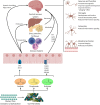The Role of Short-Chain Fatty Acids From Gut Microbiota in Gut-Brain Communication
- PMID: 32082260
- PMCID: PMC7005631
- DOI: 10.3389/fendo.2020.00025
The Role of Short-Chain Fatty Acids From Gut Microbiota in Gut-Brain Communication
Abstract
A substantial body of evidence supports that the gut microbiota plays a pivotal role in the regulation of metabolic, endocrine and immune functions. In recent years, there has been growing recognition of the involvement of the gut microbiota in the modulation of multiple neurochemical pathways through the highly interconnected gut-brain axis. Although amazing scientific breakthroughs over the last few years have expanded our knowledge on the communication between microbes and their hosts, the underpinnings of microbiota-gut-brain crosstalk remain to be determined. Short-chain fatty acids (SCFAs), the main metabolites produced in the colon by bacterial fermentation of dietary fibers and resistant starch, are speculated to play a key role in neuro-immunoendocrine regulation. However, the underlying mechanisms through which SCFAs might influence brain physiology and behavior have not been fully elucidated. In this review, we outline the current knowledge about the involvement of SCFAs in microbiota-gut-brain interactions. We also highlight how the development of future treatments for central nervous system (CNS) disorders can take advantage of the intimate and mutual interactions of the gut microbiota with the brain by exploring the role of SCFAs in the regulation of neuro-immunoendocrine function.
Keywords: central nervous system; gut microbiota; gut-brain axis; neuroinflammation; short-chain fatty acids.
Copyright © 2020 Silva, Bernardi and Frozza.
Figures

References
Publication types
MeSH terms
Substances
LinkOut - more resources
Full Text Sources
Other Literature Sources

